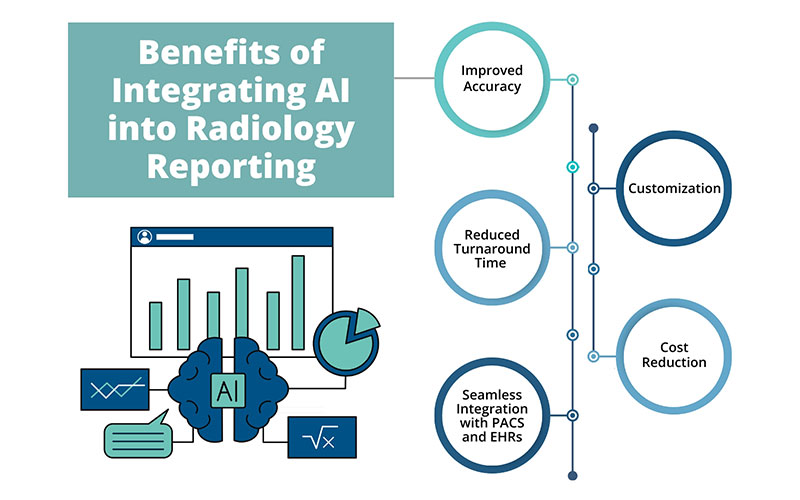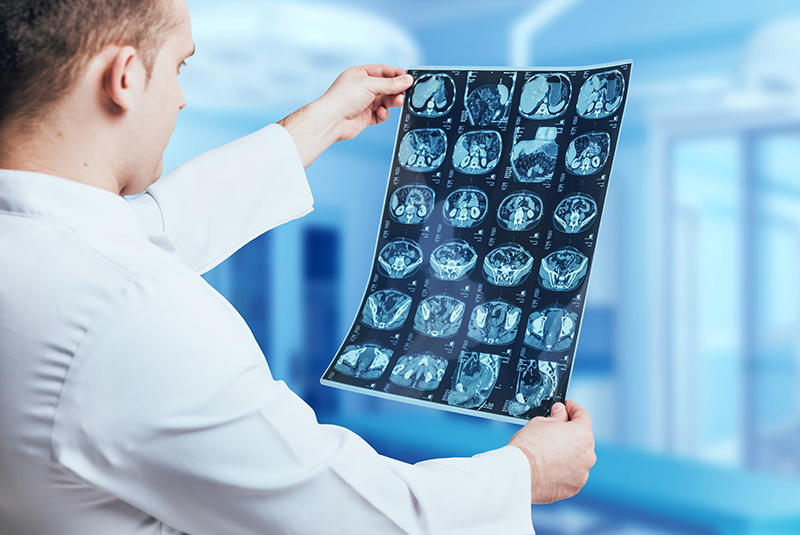
Table of Contents
The methods of generating radiology reports has come a long way from cassette-based dictation to voice recognition. While voice recognition tools improve efficiency, they still pose challenges of transcription errors. Voice recognition and transcription errors occur when a speech recognition (SR) system incorrectly interprets spoken words, leading to inaccurate text output. In fact, radiology transcription services often involve correcting SR-generated report errors caused by factors such as background noise, accents, similar-sounding words (homophones), or complex language structures. Today, studies are highlighting the potential of generative artificial intelligence (AI) to revolutionize radiology reporting.
Evolving Role of AI in Radiology
Radiology plays a crucial role in modern medicine, utilizing imaging technologies to diagnose and treat various medical conditions. The integration of AI is revolutionizing the field by enhancing diagnostic accuracy and efficiency in patient care. By analyzing medical images and recognizing patterns, AI supports clinical decision-making. Leveraging advanced algorithms and machine learning, AI systems can detect subtle abnormalities that might be overlooked by the human eye, leading to earlier disease detection and improved patient outcomes.
How AI Transforms Radiology Transcription and Reporting
Radiology transcription plays a crucial role in ensuring accurate documentation of imaging reports. However, traditional transcription methods can be time-consuming, prone to human errors, and inefficient. The integration of Artificial Intelligence (AI) into radiology transcription is transforming the field by enhancing speed, accuracy, and overall efficiency.
AI transcription works by leveraging speech recognition, natural language processing (NLP), and machine learning algorithms to convert spoken words into accurate written text.
The benefits of integrating AI into radiology reporting are:
- Improved Accuracy
AI-powered transcription tools can minimize errors by recognizing medical jargon, standardizing terminology, and reducing the risk of misinterpretation. Advanced AI models can also flag inconsistencies and suggest corrections, ensuring high-quality documentation.
- Reduced Turnaround Time
AI tools increase efficiency and speed, converting dictation to text almost instantly. By significantly reducing the turnaround time for transcribing radiology reports, AI allows radiologists to focus more on patient care rather than documentation, leading to improved workflow and productivity.
- Seamless Integration with PACS and EHRs
AI transcription systems can integrate with Picture Archiving and Communication Systems (PACS) and Electronic Health Records (EHRs), facilitating seamless data entry and retrieval. By ensuring quick access to structured patient data, this integration enables better clinical decision-making.
- Customization
AI models can be trained to adapt to specific radiologists’ speech patterns, accents, and preferences, resulting in personalized and highly accurate transcripts. With its nonstop learning ability, AI ensures continuous improvements in performance.
- Cost Reduction
Automating the transcription process reduces dependency on manual transcription services, leading to lower operational costs.
An Example of AI-Powered Efficiency in Radiology Transcription
AI is revolutionizing radiology transcription by streamlining reporting and enhancing accuracy. Rad AI Reporting exemplifies this transformation, allowing radiologists to dictate findings using their existing systems—microphone, PACS, RIS, and EHR—with AI generating precise reports within minutes.
Key benefits include:
- Faster transcription and reduced workload – AI cuts dictation time by up to 50% and reduces words dictated by 90%, alleviating cognitive strain and preventing burnout.
- Seamless integration – Works within existing reporting workflows, templates, and systems, simplifying documentation.
- Higher productivity and synchronization – Enhances efficiency, enabling twice-as-fast dictation while maintaining accuracy and integrating with other radiology tools.
- Improved report quality – AI assists in error detection and guideline compliance, ensuring more accurate reports.
- More time for imaging and patient care – By minimizing administrative tasks, radiologists can focus on image interpretation and patient outcomes.
AI-driven transcription solutions like Rad AI Reporting enhance efficiency, reduce fatigue, and improve report precision, marking a significant step forward in radiology documentation.

Challenges of AI Integration in Radiology Transcription
Despite its advantages, AI-driven radiology transcription faces certain challenges:
Data Security and HIPAA Compliance
Ensuring patient data privacy and meeting compliance requirements is critical. As a LinkedIn article points out, “AI systems require large datasets for training, which often include sensitive patient information. Ensuring patient data privacy and obtaining informed consent for data usage are critical concerns”.
Handling Complex Cases
AI systems may struggle with ambiguous or highly specialized terminology that requires expert review. A recent study in Springer Open highlighted that while AI streamlines data transfer by automatically sending findings in Digital Imaging and Communications in Medicine (DICOM) format to the PACS, this has drawbacks. AI results still require manual report entry and are sent without radiologist validation, which can lead to errors. For example, the researchers noted that false positives (like incorrect lung nodule detections) may be included, potentially misleading non-radiologist physicians and leading to misinterpretations or incorrect treatments.
Initial Implementation Costs
Implementing AI solutions requires investment in technology and training. To successfully implement AI tools in healthcare, it’s essential to involve key decision-makers and executive leadership. A Deloitte report highlights that organizations excelling in AI initiatives place leaders at the center of their AI transformations. These leaders should clearly communicate with the radiology department about how new tools will impact daily workflows.
Given these challenges, it’s crucial to have AI-generated radiology reports verified by a specialized medical transcription company. Combining advanced AI software with human transcription ensures accurate radiology transcripts, as human oversight can identify and correct errors that AI might miss.


